Make Your Own: Nature's Most Powerful Cleaner!
By Alice Osborne
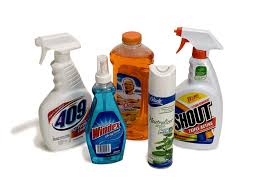 "For more than 200 years, all cleaners have pretty much worked the same--acids to break down alkaline, alkaline to break down acid, detergents to reduce surface tension so the dirt separates from the surface it's stuck to, and surfactants to encapsulate the dirt for transfer to the mop, sponge, or bucket." I just read this in one of those give-away magazines you get when you shop a natural foods store.
"For more than 200 years, all cleaners have pretty much worked the same--acids to break down alkaline, alkaline to break down acid, detergents to reduce surface tension so the dirt separates from the surface it's stuck to, and surfactants to encapsulate the dirt for transfer to the mop, sponge, or bucket." I just read this in one of those give-away magazines you get when you shop a natural foods store.
The author of the article, Dennis Voss, goes on to talk about how green manufacturers are now using enzyme blends as a new and more effective way to clean. The great thing about enzyme cleaners is that they're safe for people, pets, and the environment. Enzymes are naturally nontoxic with no fumes, no phosphates, no acids, and no petroleum. Dennis says, "The real surprise is how well they clean. Similar to the enzymes amylase, protease, and lipase that are found in many nutritional supplements, these blends rapidly biodegrade away starch, protein, fats, oils, and greases that form most common household soils."
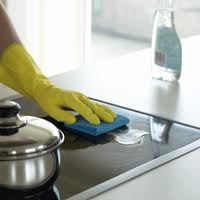 He uses as an example one of the more difficult cleaning challenges, the black glass electric stove top. Most cleaners leave the surface dull, filmy, and streaked. But enzymes actually biodegrade any splattered grease away leaving the surface sparkling clean. This is because the enzymes have broken the grease down so far that it's no longer grease.
He uses as an example one of the more difficult cleaning challenges, the black glass electric stove top. Most cleaners leave the surface dull, filmy, and streaked. But enzymes actually biodegrade any splattered grease away leaving the surface sparkling clean. This is because the enzymes have broken the grease down so far that it's no longer grease.
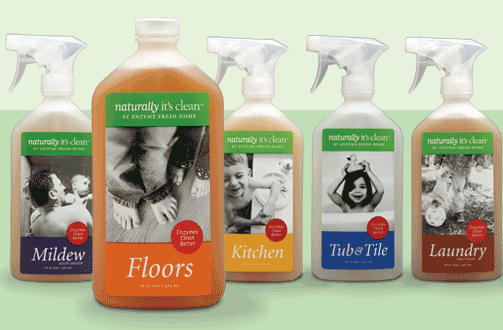 I noticed in the back of this same magazine (HealtheTimes: Live Life Natually) some advertising for commercial enzyme cleaners--Naturally It's Clean being one example (found on www.naturallyitsclean.com). I may give this product a try-all the reviews I read were either 4 or 5 star with a common comment being that this product doesn't induce headaches like most chemical cleaners do. And almost all reviewers were impressed with its cleaning ability. But in the meantime I wondered if it's possible to make our own natural enzyme cleaner, so I went sleuthing.
I noticed in the back of this same magazine (HealtheTimes: Live Life Natually) some advertising for commercial enzyme cleaners--Naturally It's Clean being one example (found on www.naturallyitsclean.com). I may give this product a try-all the reviews I read were either 4 or 5 star with a common comment being that this product doesn't induce headaches like most chemical cleaners do. And almost all reviewers were impressed with its cleaning ability. But in the meantime I wondered if it's possible to make our own natural enzyme cleaner, so I went sleuthing.
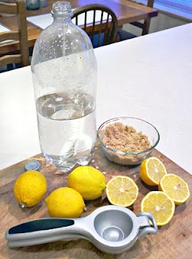 And on that dependable site, ehow.com, I found more information plus a very doable recipe (which shows up on other sites as well) for just what I was looking for. Jennifer Wagaman, the article author says: "An enzyme cleaner contains proteins that are produced by bacteria that can clean up oily spills by breaking down the oils, as well as clean up pet urine smells by essentially eating the bacteria that produces the smell. According to All Star Floor Care, the enzymes in an enzyme cleaner are not alive but are produced by living organisms and bacteria. You can make your own enzyme cleaner with just a few ingredients."
And on that dependable site, ehow.com, I found more information plus a very doable recipe (which shows up on other sites as well) for just what I was looking for. Jennifer Wagaman, the article author says: "An enzyme cleaner contains proteins that are produced by bacteria that can clean up oily spills by breaking down the oils, as well as clean up pet urine smells by essentially eating the bacteria that produces the smell. According to All Star Floor Care, the enzymes in an enzyme cleaner are not alive but are produced by living organisms and bacteria. You can make your own enzyme cleaner with just a few ingredients."
So let's put this recipe together, wait the 3 months it takes to formulate, try cleaning with it, and report back. Let's put nature's most powerful cleaner to work!
HOMEMADE ENZYME CLEANER
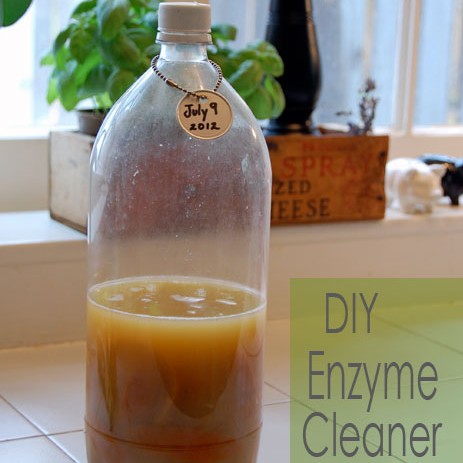
Need: Plastic container with airtight lid, brown sugar, funnel, lemon and orange peel scraps (pulp can also be added)
- 7/8 cup brown sugar
- 2 cups of lemon and orange scraps (leftover from juicing, for instance)
- 1 cup of pineapple scraps
- 4 cups of water
Using a funnel, pour the sugar into the plastic container. Cut citrus peels into sizes appropriate for the plastic container opening. Place them into the container with the sugar. Pour water into the container with the sugar, lemon and orange pieces. Replace the lid tightly on the container so air cannot get inside. Shake the container a little in order to blend the mixture.
Let the mixture ferment for 3 months before use. As it ferments, oxygen will build up in the container. If the container swells, open it to release the pressure and recap it. After 3 months, the process is complete, and the enzymes are ready for use as a household cleaner. Simply pour into a spray bottle for use around the house; this is also and excellent laundry additive: just a couple tablespoons per load will do the trick.
NOTE: This cleaner creates no suds, but you can also add a few drops of dish detergent to the final product if you'd like to use it for hand-washing dishes.
- www.online.wsj.com
- www.tlc.howstuffworks.com
- www.alternativeconsumer.com
- www.pinterest.com
- www.theartofdoingstuff.com

